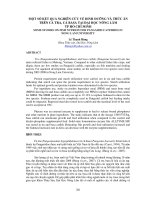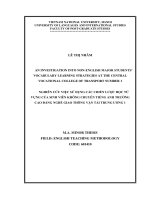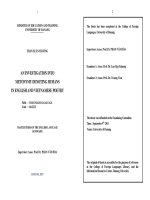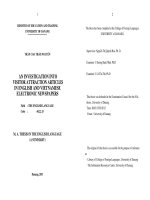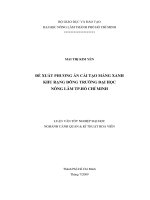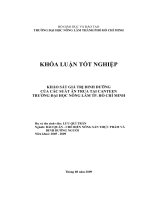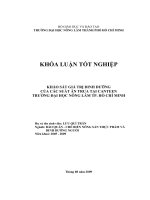An investigation into learners linguistic problems in toeic listening comprehension at the centre for foreign studies, nong lam university ho chi minh city m a 60 14 10
Bạn đang xem bản rút gọn của tài liệu. Xem và tải ngay bản đầy đủ của tài liệu tại đây (931.18 KB, 147 trang )
VIETNAM NATIONAL UNIVERSITY-HCM CITY
UNIVERSITY OF SOCIAL SCIENCES AND HUMANITIES
DEPARTMENT OF ENGLISH LINGUISTICS AND LITERATURE
AN INVESTIGATION INTO LEARNERS’
LINGUISTIC PROBLEMS IN TOEIC LISTENING
COMPREHENSION AT THE CENTRE FOR
FOREIGN STUDIES, NONG LAM UNIVERSITY
– HOCHIMINH CITY
A thesis submitted to the Faculty of the Department of English Linguistics and
Literature in partial fulfillment of the Master’s degree in TESOL
By
NGUYỄN ĐẶNG THỊ CÚC HUYỀN
Supervised by
TRƯƠNG HỚN HUY, M.A. Senior Lecturer
HO CHI MINH CITY – NOVEMBER 2011
i
i
TABLE OF CONTENTS
Page
Table of contents
i
List of tables
v
List of charts
vi
Abbreviations
vii
Statement of authorship
viii
Retention and use of the thesis
ix
Acknowledgements
x
Abstract
xi
Chapter 1: INTRODUCTION
1
1.1 The rationale of the study
1
1.2 Aims of the study
3
1.3 Background to the study
3
1.4 Significance of the study
4
1.5 Limitations
5
1.6 Structure of the thesis
6
Chapter 2: LITERATURE REVIEW
7
2.1 An overview of listening comprehension
7
2.1.1 Definitions
7
2.1.2 Types of knowledge used in listening
8
2.1.3 The nature of listening comprehension
9
2.1.4 The role of listening comprehension in language learning
11
2.2 Listening processes
12
2.2.1 The bottom-up process
13
2.2.2 The top-down process
13
2.2.3 Combining the bottom-up and top-down models
14
2.3 Listening stages
15
ii
2.3.1 The pre-listening stage
15
2.3.2 The while-listening stage
16
2.3.3 The post-listening stage
18
2.4 Listening strategies
19
2.5 Linguistic problems of listening to English
20
2.5.1 Phonological features
22
2.5.2 Lexical features
28
2.5.3 Syntactic features
31
2.5.4 Semantic features
33
2.5.5 Discourse structure features
34
Chapter 3: METHODOLOGY
37
3.1 Research questions
37
3.2 Research design
37
3.2.1 The subjects
38
3.2.1.1 The first group of subjects
38
3.2.1.2 The second group of subjects
40
3.2.2 Data collection instruments
3.2.2.1 Questionnaires
40
40
3.2.2.1.1 Questionnaire for learners
41
3.2.2.1.2 Questionnaire for teachers
42
3.2.2.2 Interview
3.2.3 Data collection procedures
43
44
Chapter 4: DATA ANALYSIS AND RESULTS
46
4.1 Results from teachers’ questionnaire
46
4.1.1
Learners’ problems in TOEIC listening comprehension
46
4.1.1.1 Problems with phonological features
46
4.1.1.2 Problems with lexical features
48
4.1.1.3 Problems with syntactic features
50
4.1.2
Teachers’ assessment of linguistic knowledge’s support
towards listening comprehension
52
iii
4.1.3 Teachers’ suggestions to improve learners’ listening
comprehension
4.2 Results from learners’ questionnaire
52
53
4.2.1 Learners’ perception of English skills
53
4.2.2 The importance of listening comprehension
54
4.2.3 Learners’ self-assessment of listening ability
55
4.2.4 Learners’ problems in learning TOEIC listening comprehension 56
4.2.4.1 Problems with phonological features
56
4.2.4.2 Problems to lexical features
59
4.2.4.3 Problems with syntactic features
61
4.2.5 Learners’ self-assessment of linguistic knowledge’s support
towards listening comprehension
62
4.2.6 Learners’ listening practice at home
63
4.2.7 Strategies of learning listening comprehension
64
4.2.8 Ways to improve listening skills
65
4.3 Results from learners’ interview
66
4.3.1 Learners’ problems in learning TOEIC listening comprehension 66
4.3.1.1 Problems with phonological features
66
4.3.1.2 Problems with lexical features
68
4.3.1.3 Problems with syntactic features
69
4.3.2 Possible causes of the linguistic problems
70
4.3.3 Ways to improve learners’ listening comprehension
72
4.3.3.1 Ways teachers can do to help learners improve
listening comprehension
72
4.3.3.2 Ways learners can do to improve their listening
74
4.3.4 Learners’ opinions on the support of linguistic knowledge
towards listening comprehension
75
Chapter 5: CONCLUSION AND RECOMMENDATIONS
77
5.1 Conclusion
77
5.2 Pedagogical implications
79
iv
5.2.1 To teachers
79
5.2.2 To learners
81
5.3 Recommendations for further research
82
APPENDIX 1: Questionnaire for teachers
84
APPENDIX 2: Questionnaire for learners (in Vietnamese)
88
APPENDIX 3: Questionnaire for learners (in English)
94
APPENDIX 4: Interview questions for learners (in Vietnamese)
100
APPENDIX 5: Interview questions for learners (in English)
101
REFERENCES
103
v
LIST OF TABLES
Page
3.1 Characteristics of the first group of subjects (learners)
39
3.2 Characteristics of the second group of subjects (teachers)
40
4.1 Teachers’ opinions on learners’ phonological problems in
TOEIC listening comprehension
47
4.2 Teachers’ opinions on learners’ lexical problems in TOEIC
listening comprehension
49
4.3 Teachers’ opinions on learners’ syntactic problems in
TOEIC listening comprehension
51
4.4 Teachers’ suggestions to improve learners’ listening ability
53
4.5 Learners’ explanation for the importance of listening comprehension
55
4.6 Learners’ self-assessment of listening ability
55
4.7 Learners’ phonological problems in TOEIC listening comprehension
57
4.8 Learners’ lexical problems in TOEIC listening comprehension
59
4.9 Learners’ syntactic problems in TOEIC listening comprehension
61
4.10 Learners’ ways for extra listening practice
64
4.11 Learners’ ways of learning listening comprehension
64
vi
LIST OF CHARTS
Page
4.1 Teachers’ assessment of linguistic knowledge’s support
towards listening comprehension
52
4.2 Learners’ perception of the difficulty among four English skills
54
4.3 Learners’ perception of the importance of listening comprehension
55
4.4 Learners’ self-assessment of linguistic knowledge’s support towards
listening comprehension
62
4.5 Learners’ listening practice at home
63
4.6 The hours of learners’ listening practice at home
63
vii
ABBREVIATIONS
CFS: Centre for Foreign Studies
EFL: English as a Foreign Language
ESL: English as a Second Language
L1: First language
L2: Second language
NLU: Ho Chi Minh City Nong Lam University
TOEIC: The Test of English for International Communication
C.33.44.55.54.78.65.5.43.22.2.4..22.Tai lieu. Luan 66.55.77.99. van. Luan an.77.99.44.45.67.22.55.77.C.37.99.44.45.67.22.55.77.C.37.99.44.45.67.22.55.77.C.37.99.44.45.67.22.55.77.C.33.44.55.54.78.655.43.22.2.4.55.22. Do an.Tai lieu. Luan van. Luan an. Do an.Tai lieu. Luan van. Luan an. Do an
viii
STATEMENT OF AUTHORSHIP
I hereby certify that this thesis entitled “An Investigation into Learners’ Linguistic
Problems in TOEIC Listening Comprehension at the Centre for Foreign Studies,
Nong Lam University – Hochiminh City” is my own work.
This thesis has not been submitted for the award of any degree or diploma in any
other institution.
Ho Chi Minh City, November 29th, 2011
NGUYEN DANG THI CUC HUYEN
@edu.gmail.com.vn.bkc19134.hmu.edu.vn
C.33.44.55.54.78.65.5.43.22.2.4..22.Tai lieu. Luan 66.55.77.99. van. Luan an.77.99.44.45.67.22.55.77.C.37.99.44.45.67.22.55.77.C.37.99.44.45.67.22.55.77.C.37.99.44.45.67.22.55.77.C.33.44.55.54.78.655.43.22.2.4.55.22. Do an.Tai lieu. Luan van. Luan an. Do an.Tai lieu. Luan van. Luan an. Do an
ix
RETENTION AND USE OF THE THESIS
I hereby state that I, NGUYEN DANG THI CUC HUYEN, being the candidate for
the degree of Master of TESOL at the University of Social Sciences and
Humanities, accept the requirements of the University relating to the retention and
the use of Master’s Theses deposited in Library.
In terms of these conditions, I agree that the original of my thesis deposited in the
Library should be accessible for purposes of study and research, in accordance
with the normal conditions established by Library for the care, loan or
reproduction of theses.
Ho Chi Minh City, November 29th, 2011
NGUYEN DANG THI CUC HUYEN
@edu.gmail.com.vn.bkc19134.hmu.edu.vn
C.33.44.55.54.78.65.5.43.22.2.4..22.Tai lieu. Luan 66.55.77.99. van. Luan an.77.99.44.45.67.22.55.77.C.37.99.44.45.67.22.55.77.C.37.99.44.45.67.22.55.77.C.37.99.44.45.67.22.55.77.C.33.44.55.54.78.655.43.22.2.4.55.22. Do an.Tai lieu. Luan van. Luan an. Do an.Tai lieu. Luan van. Luan an. Do an
x
ACKNOWLEDGEMENTS
First of all, I would like to express my deepest gratitude to my supervisor, Mr.
TRUONG HON HUY, who offered me valuable comments and guidance to the
completion of this thesis. Without his encouragement and assistance, this work
would not have been completed.
I am also grateful to all of my teachers for their helpful instructions during the
M.A. course.
I would like to extend my sincere thanks to all the students, who were willing to
answer the questionnaire and participate in the interview and to teachers at the
Centre for Foreign Studies, Nong Lam University – Hochiminh City for their help
with the data collection.
Last but not least, my special thanks go to my family, especially my husband, who
bore a great deal of hardships during the execution of the thesis. Without their
patience, it would not have been possible.
@edu.gmail.com.vn.bkc19134.hmu.edu.vn
C.33.44.55.54.78.65.5.43.22.2.4..22.Tai lieu. Luan 66.55.77.99. van. Luan an.77.99.44.45.67.22.55.77.C.37.99.44.45.67.22.55.77.C.37.99.44.45.67.22.55.77.C.37.99.44.45.67.22.55.77.C.33.44.55.54.78.655.43.22.2.4.55.22. Do an.Tai lieu. Luan van. Luan an. Do an.Tai lieu. Luan van. Luan an. Do an
xi
ABSTRACT
This thesis aims at (1) investigating the common linguistic problems faced by the
learners at the Centre for Foreign Studies, Nong Lam University – Hochiminh City
in TOEIC listening comprehension; (2) exploring the main causes of those
problems; and (3) suggesting some possible ways to improve the teaching and
learning of TOEIC listening comprehension. The informants in this study were
intermediate learners of English who were taking a TOEIC preparation course at
the Centre for Foreign Studies, Nong Lam University. Both qualitative and
quantitative research methods were employed in this study. Data were collected
through two questionnaires on learners’ linguistic problems – one for one hundred
and sixty-nine students and one for ten Vietnamese teachers of English. In
addition, interviews were also conducted with ten students to get more in-depth
information about their linguistic problems. The study discovered that
phonological problems such as recognizing the sounds, distinguishing similar
sounds, catching up the coming sounds, different accents, stress and intonation,
phonological variations were frequently faced by the majority of learners. Slang,
idioms, unknown words, multiple-meaning words, and lexical density were
frequent lexical problems that the learners encountered. Syntactic features,
however, did not prevent learners a great deal in listening process. With regard to
the possible causes of the problems, the main sources included the difference
between English and Vietnamese, learners’ poor English backgrounds, insufficient
extra listening practice, the lack of linguistic knowledge, and inappropriate
listening strategies. Learners acknowledged that linguistic knowledge supported
them a great deal in listening comprehension and, therefore, they should be given
more opportunities to listen to spoken discourse at home, employ a greater number
and range of listening strategies, and improve their linguistic knowledge and
background knowledge.
@edu.gmail.com.vn.bkc19134.hmu.edu.vn
C.33.44.55.54.78.65.5.43.22.2.4..22.Tai lieu. Luan 66.55.77.99. van. Luan an.77.99.44.45.67.22.55.77.C.37.99.44.45.67.22.55.77.C.37.99.44.45.67.22.55.77.C.37.99.44.45.67.22.55.77.C.33.44.55.54.78.655.43.22.2.4.55.22. Do an.Tai lieu. Luan van. Luan an. Do an.Tai lieu. Luan van. Luan an. Do an
1
CHAPTER 1
INTRODUCTION
This thesis studies linguistic problems in TOEIC listening comprehension
faced by Vietnamese learners of English at the intermediate level at the Centre
for Foreign Studies (CFS), Ho Chi Minh City Nong Lam University (NLU) – Thu Duc
Annex, and attempts to identify the causes of their difficulties and problems.
Then, based on the findings, the thesis comes up with a number of solutions to
help students partly solve their problems and enhance their TOEIC listening
comprehension.
This chapter presents the rationale of the study, the aims, the background
to the study, significance, limitations, and the structure of the thesis.
1.1 The rationale of the study
It is believed that English is a vital instrument that helps Vietnam develop
and integrate with the world in the fields of economy, politics, culture, etc.
Vietnam is recognized as a country with a great economic potential, so a large
number of corporations all over the world have set up their companies, factories,
or services in Vietnam. Moreover, known as a beautiful country with famous
landscapes and hospitable people, Vietnam attracts a great number of tourists
every year. With a growing economy, the demand for English speaking proficiency
among workers and people has been on the rise.
English language learning and teaching in Vietnam has become extremely
important over the past several years and has focused more on communicative
competence of learners. People seem to identify communication with speaking;
however, it is obvious that a communicative act involves both expression and
interpretation. According to Doff (1988:198), “We cannot develop speaking skills
@edu.gmail.com.vn.bkc19134.hmu.edu.vn
C.33.44.55.54.78.65.5.43.22.2.4..22.Tai lieu. Luan 66.55.77.99. van. Luan an.77.99.44.45.67.22.55.77.C.37.99.44.45.67.22.55.77.C.37.99.44.45.67.22.55.77.C.37.99.44.45.67.22.55.77.C.33.44.55.54.78.655.43.22.2.4.55.22. Do an.Tai lieu. Luan van. Luan an. Do an.Tai lieu. Luan van. Luan an. Do an
2
unless we also develop listening skills; to have a successful conversation, students
must understand what is said to them.” Wilson (2008:17) claims that in the past
learners learnt foreign languages by reading and translating only. However, in the
late twentieth century, with the developments of linguistics, sociology and
anthropology, research has indicated that listening is the key initial skill in
learning both first and second languages. People cannot talk without listening
first.
In fact, listening is the most frequently used language skill in daily life. The
time we spend in listening far exceeds the time spent in reading, writing, or
speaking. Researchers (e.g. Morley, 1991; River, 1981; Weaver, 1972, cited in
Celce-Murcia and Olshtain, 1995:102) estimate that we listen to twice as much
language as we speak, four times as much as we read, and five times as much as
we write. In recent years, listening comprehension has received increasing
recognition as a language skill that ought to be researched and taught in its own
right. It is an important skill, but it is probably the most difficult one to learn and
teach.
Along with the development of our society, a great number of companies
need excellent employees with English competences; universities need to train
students who can work well in their majors and can also speak English to meet
work’s demand and requirement of the Ministry of Education and Training. There
should be a tool to assess English competence. The TOEIC test has become a
recognized standard for a large number of organizations around the world that
need to evaluate the English proficiency of prospective or existing employees.
Administrators of language programs find that the TOEIC test is an excellent
placement tool and a valuable measure of post-training proficiency. Many
universities and institutions of higher education require that their students take
the TOEIC test prior to graduation. Thus, the need for learning and taking TOEIC
test is increasing. However, when Vietnamese learners learn TOEIC, they face
@edu.gmail.com.vn.bkc19134.hmu.edu.vn
C.33.44.55.54.78.65.5.43.22.2.4..22.Tai lieu. Luan 66.55.77.99. van. Luan an.77.99.44.45.67.22.55.77.C.37.99.44.45.67.22.55.77.C.37.99.44.45.67.22.55.77.C.37.99.44.45.67.22.55.77.C.33.44.55.54.78.655.43.22.2.4.55.22. Do an.Tai lieu. Luan van. Luan an. Do an.Tai lieu. Luan van. Luan an. Do an
3
many difficulties due to different reasons; and the learners of English who are
taking TOEIC preparation courses at CFS, NLU are not an exception. A
considerable number of these learners have said that they are satisfied with
neither their listening comprehension ability nor the score in Listening
Comprehension Section of the TOEIC test at their levels. Faerch and Kasper (1986)
assert that learners need to experience their comprehension problems. They
suggest that only by working on the problems that arise in trying to understand a
sample of L2 input that learners become aware of gaps in their internal L2
systems (cited in Anderson and Lynch, 1988:35). In other words, to help learners
comprehend better in listening comprehension as well as communicate more
efficiently, teachers need to help them realize their listening problems.
According to Richards, Platt, and Platt (1992:216), “The study of listening
comprehension processes in second language learning focuses on the role of
individual linguistic units (e.g. phonemes, words, grammatical structure) as well
as the role of listener’s expectations, the situation and context, background
knowledge, and the topic.” Buck (2001:3) also states that, “We should not
underestimate the importance of the acoustic input, nor the importance of the
linguistic information.” Based on the integrative study of linguistic problems, the
learners’ reflection, and the researcher’s own teaching experience, the author
conducted an investigation into linguistic problems faced by learners at CFS, NLU
regarding TOEIC listening comprehension with the hope of helping her students
improve their listening skills.
1.2 Aims of the study
The aims of this study are:
(i) to investigate the common linguistic problems faced by the learners at
CFS, NLU in Listening Comprehension Section of the TOEIC test,
(ii) to find out the main causes of those problems, and
@edu.gmail.com.vn.bkc19134.hmu.edu.vn
C.33.44.55.54.78.65.5.43.22.2.4..22.Tai lieu. Luan 66.55.77.99. van. Luan an.77.99.44.45.67.22.55.77.C.37.99.44.45.67.22.55.77.C.37.99.44.45.67.22.55.77.C.37.99.44.45.67.22.55.77.C.33.44.55.54.78.655.43.22.2.4.55.22. Do an.Tai lieu. Luan van. Luan an. Do an.Tai lieu. Luan van. Luan an. Do an
4
(iii) to suggest some feasible solutions to the problems.
1.3 Background to the study
This section is a brief discussion of CFS, NLU and TOEIC test. It aims at
providing general background information necessary for an understanding of the
issues employed in this thesis.
The CFS, NLU is a nationally accredited language institution, founded
according to Decision No. 331/QD dated March 14, 1990, and Decision No.
884/QD dated May 2, 1992, by the Minister of Education and Training. The
NLU/CFS is one of the premier English language centers in Ho Chi Minh City as
well as the whole country.
The Center’s major functions include teaching foreign languages, mainly
English, to adult learners, administering various international tests, organizing
faculty and student exchange, promoting opportunities for cultural and
linguistic exchange and teaching, developing international education programs,
and finally conducting research on distance education, development education
and language teaching and learning. (“About Us” Nong Lam University Centre for
Foreign Studies, retrieved at March 10, 2011 from )
One of the major training programs at CFS, NLU is the Business English
program (TOEIC training). The program develops not only students’ skills in
getting high score on the TOEIC test but also their English proficiency and
knowledge necessary for work. TOEIC is a multiple-choice test of English for nonnative speakers of English. “The TOEIC test was designed to meet the needs of
the working world” (Arbogast et all, 2001:7), and “to meet the need for a
measure of English language skills outside of the traditional academic context”
(Woodford, 1982:4). The TOEIC test contains two sections, Listening
Comprehension and Reading Comprehension, each of which includes one
hundred questions.
@edu.gmail.com.vn.bkc19134.hmu.edu.vn
C.33.44.55.54.78.65.5.43.22.2.4..22.Tai lieu. Luan 66.55.77.99. van. Luan an.77.99.44.45.67.22.55.77.C.37.99.44.45.67.22.55.77.C.37.99.44.45.67.22.55.77.C.37.99.44.45.67.22.55.77.C.33.44.55.54.78.655.43.22.2.4.55.22. Do an.Tai lieu. Luan van. Luan an. Do an.Tai lieu. Luan van. Luan an. Do an
5
In the Listening Comprehension Section, the examinee is “required to
listen to a variety of recorded English stimulus material and answer questions
printed in English in the test book that are based on the recorded stimuli”
(Woodford, 1982:4). The test questions are developed from samples of spoken
and written language collected from various countries around the world where
English is used in the workplace. Test questions include different settings and
situations, such as general business, manufacturing, finance and budgeting,
corporate development, offices, personnel, purchasing, technical areas,
housing/corporate property, travel, dining out, entertainment, and health. The
TOEIC test “is suitable for use in all environments where English is used by native
speakers of other languages” (Arbogast et all, 2001:7).
1.4 Significance of the study
It is hoped that this study will help learners as well as teachers realize
common linguistic problems and causes of those problems which learners at CFS,
NLU encounter in TOEIC listening comprehension. Hopefully, the study’s findings
concerning listening problems, causes, and recommendations may help both
instructors and learners have a critical look at linguistic knowledge when teaching
and learning listening comprehension, and know how to apply teaching and
learning techniques and methodology to the syllabus of the CFS, NLU and use
effective strategies in teaching and learning listening skills. In addition, the
research is a crucial step in exploring more appropriate methods in teaching
listening skills.
1.5 Limitations
The investigation only focuses on the issues: (i) linguistic problems facing
learners at CFS, NLU in TOEIC listening comprehension; (ii) causes of those
problems; and (iii) recommendations for teaching and learning TOEIC listening
comprehension.
@edu.gmail.com.vn.bkc19134.hmu.edu.vn
C.33.44.55.54.78.65.5.43.22.2.4..22.Tai lieu. Luan 66.55.77.99. van. Luan an.77.99.44.45.67.22.55.77.C.37.99.44.45.67.22.55.77.C.37.99.44.45.67.22.55.77.C.37.99.44.45.67.22.55.77.C.33.44.55.54.78.655.43.22.2.4.55.22. Do an.Tai lieu. Luan van. Luan an. Do an.Tai lieu. Luan van. Luan an. Do an
6
Due to the time limit, the thesis cannot cover all problems that the learners face
when they learn TOEIC Listening Comprehension Section. It just focuses on the
linguistic problems, through which, as the researcher believes, learners can
increase their attention, develop their listening skills, and improve their TOEIC
listening scores. Linguistic problems cover five levels, including phonology, lexis,
syntax, semantics, and discourse structures; nevertheless, the thesis mainly deals
with phonological, lexical, and syntactic problems for two reasons. Firstly,
“semantics is usually concerned with the analysis of the meaning of words,
phrases, or sentences, and sometimes with the meaning of utterances in
discourse or the meaning of a whole text” (Richards, Plat, and Plat, 1992:222). As
a result, semantic problems are related to word meaning and meaning of
syntactic structure, so they are partly discussed in lexical and syntactic problems.
Secondly, discourse structure feature is a very big problem that cannot be
covered in this thesis because of the difficulty in terms of lack of material and
time. Moreover, in the TOEIC test, “the texts are too short to include many
discourse features. There are virtually no tasks requiring any discourse
processing” (Buck, 2001:211).
The study only deals with learners who are taking TOEIC preparation
courses at CFS, NLU and is applied for this setting. However, this study, if
flexibly modified, can hopefully work with other learners at other language centers
who face similar problems in TOEIC listening comprehension.
1.6 Structure of the thesis
This thesis consists of five chapters:
Chapter one, introduction, identifies the problems leading to the thesis
and the background in which the study was carried out, states the aims, the
significance, the limitations of the study as well as the structure of the thesis.
@edu.gmail.com.vn.bkc19134.hmu.edu.vn
C.33.44.55.54.78.65.5.43.22.2.4..22.Tai lieu. Luan 66.55.77.99. van. Luan an.77.99.44.45.67.22.55.77.C.37.99.44.45.67.22.55.77.C.37.99.44.45.67.22.55.77.C.37.99.44.45.67.22.55.77.C.33.44.55.54.78.655.43.22.2.4.55.22. Do an.Tai lieu. Luan van. Luan an. Do an.Tai lieu. Luan van. Luan an. Do an
7
Chapter two, literature review, presents a review of related literature and
research on listening comprehension, and problems in terms of linguistic features
in listening comprehension.
Chapter three, methodology, provides a description of the research design
and methodology including the subjects’ selection, data collection instruments,
and data collection procedures.
Chapter four, data analysis and results, analyzes the data and discusses
research findings.
Chapter five, conclusion and recommendations, gives the conclusion of the study
and recommendations for teaching and learning TOEIC listening comprehension.
@edu.gmail.com.vn.bkc19134.hmu.edu.vn
C.33.44.55.54.78.65.5.43.22.2.4..22.Tai lieu. Luan 66.55.77.99. van. Luan an.77.99.44.45.67.22.55.77.C.37.99.44.45.67.22.55.77.C.37.99.44.45.67.22.55.77.C.37.99.44.45.67.22.55.77.C.33.44.55.54.78.655.43.22.2.4.55.22. Do an.Tai lieu. Luan van. Luan an. Do an.Tai lieu. Luan van. Luan an. Do an
8
CHAPTER 2
LITERATURE REVIEW
This chapter presents the review of related literature to the study,
including an overview of listening comprehension, listening processes, listening
stages, listening strategies, and linguistic problems of listening to English.
2.6 An overview of listening comprehension
2.6.1 Definitions
It seems to be not easy to give a clear definition of listening since there are
various aspects of listening comprehension. Listening means “different things to
different people” (Anderson and Lynch, 1988:64). Each linguist has suggested
their own different way to define listening.
Rost (2001) and Richards, Platt, and Platt (1992) define listening as a
complex process of understanding spoken language. Samovar and Mill (1980) and
Spearritt (1962) distinguish hearing from listening, and consider listening is
broader than hearing. Hearing perceives sounds only, but listening involves
directed attention by a subject to these sounds. In the context of verbal
communication, “listening is often taken to include the active process involved in
attaching meanings to the sounds” (Spearritt, 1962:4).
Underwood (1989:1) states, “Listening is an activity of paying attention to
and trying to get meaning from something we hear.” To listen successfully to
spoken language, we need to be able to work out what speakers mean when they
use particular words in particular ways on particular occasions, and not simply to
understand the words themselves. Also, Thomlison’s (1984) definition of listening
includes “active listening,” which goes beyond comprehending as understanding
@edu.gmail.com.vn.bkc19134.hmu.edu.vn
C.33.44.55.54.78.65.5.43.22.2.4..22.Tai lieu. Luan 66.55.77.99. van. Luan an.77.99.44.45.67.22.55.77.C.37.99.44.45.67.22.55.77.C.37.99.44.45.67.22.55.77.C.37.99.44.45.67.22.55.77.C.33.44.55.54.78.655.43.22.2.4.55.22. Do an.Tai lieu. Luan van. Luan an. Do an.Tai lieu. Luan van. Luan an. Do an
9
the message content, to comprehending as an act of empathetic understanding
of the speaker.
According to Howatt and Dakin (1974), listening is the ability to identify
and understand what others are saying. This process involves understanding a
speaker’s accent or pronunciation, the speaker’s grammar and vocabulary, and
comprehension of meaning. An able listener is capable of doing these things
simultaneously. Ronald and Roskelly (1985) mention that listening is an active
process requiring the same skills of prediction, hypothesizing, checking, revising,
and generalizing. Similarly, Rivers and Temperley (1978:63) claim, “Listening is a
complex operation integrating the distinct components of perception and
linguistic knowledge.”
Whatever the definition of listening, it is clearly understood that listening
comprehension is a very complicated act. Linguists have tried to explain this
phenomenon from several viewpoints, each of which can provide teachers some
clues to their students’ problems in listening to a foreign language and suggest
ways of structuring effective methods for learning and practicing.
2.6.2 Types of knowledge used in listening
To understand a message, listeners have to use their knowledge. They use
not only knowledge of the language but other types of knowledge.
Buck (2001:1-2) states that a number of different types of knowledge are
used in comprehension involving linguistic knowledge and non-linguistic
knowledge. The most important linguistic knowledge is knowledge of phonology,
lexis, syntax, semantics, and discourse structure. The non-linguistic knowledge is
knowledge about the topic, the context, and general world knowledge.
Widdowson (1983) points out two kinds of knowledge which are systemic
or linguistic knowledge and schematic or non-linguistic information. Linguistic
@edu.gmail.com.vn.bkc19134.hmu.edu.vn
C.33.44.55.54.78.65.5.43.22.2.4..22.Tai lieu. Luan 66.55.77.99. van. Luan an.77.99.44.45.67.22.55.77.C.37.99.44.45.67.22.55.77.C.37.99.44.45.67.22.55.77.C.37.99.44.45.67.22.55.77.C.33.44.55.54.78.655.43.22.2.4.55.22. Do an.Tai lieu. Luan van. Luan an. Do an.Tai lieu. Luan van. Luan an. Do an
10
knowledge includes knowledge of phonological, syntactic, and semantic
components of language system; non-linguistic information includes background
knowledge (factual and socio-cultural knowledge) and procedural knowledge
(cited in Anderson and Lynch, 1988).
Background knowledge helps learners to understand the meaning of a
message. Anderson and Lynch (1988:11-12) clarify that previous knowledge –
sometimes called “background knowledge” or “knowledge of the world – is
“central to the way we understand language,” whether through listening or
reading. The term covers a range of knowledge types, any of which we may need
to draw on in order to reach an adequate comprehension of what someone has
said or written.
Anderson and Lynch (1988:13) argue that it is very difficult to distinguish
which kind of knowledge the learners use in comprehension in a clear or
conscious way, and to know what was actually said and what was constructed by
integrating the spoken words with their own knowledge.
Knowing all types of knowledge used in listening may be a great help to
students in order that they spend time not only learning linguistic features but
also enlarging their background knowledge, both of which play important roles in
success of acquiring listening skills.
2.6.3 The nature of listening comprehension
Exploring the nature of listening comprehension is first thing to find out
appropriate methods of listening learning and teaching as well as to improve its
outcomes.
Listening skills did not receive adequate attention in language teaching for
a long time. Applied linguists often disregarded the nature of listening
comprehension, and assumed that “listening skills could be acquired through
@edu.gmail.com.vn.bkc19134.hmu.edu.vn
C.33.44.55.54.78.65.5.43.22.2.4..22.Tai lieu. Luan 66.55.77.99. van. Luan an.77.99.44.45.67.22.55.77.C.37.99.44.45.67.22.55.77.C.37.99.44.45.67.22.55.77.C.37.99.44.45.67.22.55.77.C.33.44.55.54.78.655.43.22.2.4.55.22. Do an.Tai lieu. Luan van. Luan an. Do an.Tai lieu. Luan van. Luan an. Do an
11
exposure but not really taught” (Richards and Renandya, 2002:235). Traditionally,
listening and reading were assumed to be passive skills, and speaking and writing
were active skills.
However, Anderson and Lynch (1988:6) disclaim a conceptualization of
“listening as a passive act” or “listener as tape recorder”. They argue that in the
process of listening comprehension, listeners do not passively receive and record
what a speaker says, but they actively apply their various types of knowledge and
their experience to interpret and understand what they hear.
Lee and VanPatten (1995:60) also argue against the view that listening is a
passive skill in the way that the listener is a mere bystander during
communication, a submissive individual, unable to act, who does not participate
and merely accepts whatever is thrown her way. They believe that listeners are
active communicators using a variety of mental processes and knowledge
sources, and thus listening is a dynamic process.
Rivers and Temperley (1978:63) mention the cognitive nature of listening
which involves perception based on internalized knowledge of the rules of the
language. Listening is an active process of message construction with what one
knows of the phonological, semantic, and syntactic potentialities of the language.
While constructing a message from a stream of sound, students anticipate the
import of the message, hold segments already identified in their immediate
memory and readjust their interpretation of earlier segments in accordance with
the final message.
Underwood (1989) and Wilson (2008) also share the same idea with the
above researchers. Listening is an active skill, not passive. Underwood (1989:2)
claims that while hearing can be thought of as a passive condition, “listening is
always an active process.” Indeed, it is extremely active, but all the activity
happens in the mind. Listeners guess, predict, infer, criticize and, above all,
@edu.gmail.com.vn.bkc19134.hmu.edu.vn
C.33.44.55.54.78.65.5.43.22.2.4..22.Tai lieu. Luan 66.55.77.99. van. Luan an.77.99.44.45.67.22.55.77.C.37.99.44.45.67.22.55.77.C.37.99.44.45.67.22.55.77.C.37.99.44.45.67.22.55.77.C.33.44.55.54.78.655.43.22.2.4.55.22. Do an.Tai lieu. Luan van. Luan an. Do an.Tai lieu. Luan van. Luan an. Do an
12
interpret. “Listening, then, is an activity that takes place on many levels
simultaneously, from recognition of individual phonemes to recognition of
patterns of intonation that alert us to irony, sarcasm, anger, delight” (Wilson,
2008:21-22).
Brown (1990) states that listeners are not simply passive processors. They
are active searchers for meaning by using their all relevant background
knowledge, knowledge of the physical context of the utterance (the immediate
surroundings, the place, the time), knowledge of the speaker (gender, age, known
opinions), knowledge of the topic. “Armed with this activated knowledge, the
listener monitors the incoming acoustic signal, which will simultaneously shape
and conform his expectations” (Brown, 1990:11). The statement confirms that
listening is an active process rather than a straightforward matching of sound to
meaning as it was assumed.
In summary, it is now generally agreed that listening is an active process,
not a passive one. Effective listening requires as much attention and mental
activity as speaking and writing that were always assumed as active skills and
demands conscientious effort of the listener. Understanding the nature of
listening comprehension leads both instructors and learners to a great attention
in language teaching and learning.
2.6.4 The role of listening comprehension in language learning
Researchers agree that listening is perhaps one of the most important
skills, yet it is probably the least understood, the least researched and,
historically, the least valued (Rost, 2001; Brown, 2006; Wilson, 2008). Listening in
language teaching has undergone several important influences. David Nunan
(1999) describes listening as “the Cinderella skill”, overshadowed by its big sister,
speaking. However, along with the elaboration of a psychological theory of child
acquisition, listening has become a vital component in language learning. It is not
@edu.gmail.com.vn.bkc19134.hmu.edu.vn
C.33.44.55.54.78.65.5.43.22.2.4..22.Tai lieu. Luan 66.55.77.99. van. Luan an.77.99.44.45.67.22.55.77.C.37.99.44.45.67.22.55.77.C.37.99.44.45.67.22.55.77.C.37.99.44.45.67.22.55.77.C.33.44.55.54.78.655.43.22.2.4.55.22. Do an.Tai lieu. Luan van. Luan an. Do an.Tai lieu. Luan van. Luan an. Do an
13
only a skill area in language performance, but also a critical means of acquiring a
second language (Rost, 2001). The researchers provide crucial reasons
emphasizing the significance of listening in language learning.
Krashen (1985), Rost (1994), Goh, (2002) claim that in language classroom
listening ability plays a significant role in the development of other language
skills. “When students first learn a language, they have to listen to the words
several times before they are able to recognize and pronounce those words”
(Goh, 2002:ii). Rost (1994, cited in Richards and Rennandya 2002:239) states that
listening is really important because it provides input for the learners. Without
understanding input at the right level, any learning simply can not begin. Krashen
(1985) also argues that people acquire language by understanding the linguistic
information they hear. Thus, language acquisition is achieved mainly by receiving
understandable input, and listening is the core component in achieving
understandable language input.
Moreover, according to Doff (1988:198), listening is an important way of
“acquiring the language” – of “picking up structures and vocabulary.” Listening
can also help students build vocabulary, develop language proficiency, and
improve language usage (Barker, 1971, cited in Goh, 2000:ii).
Hammer (2007:133) states that listening is also good for student’s
pronunciation because the more students hear and understand English being
spoken, the more they absorb appropriate pitch and intonation, stress and the
sounds of both individual words and those in connected speech.
Indeed, it is worth remembering that successful spoken communication
depends not only on our ability to speak, but also on the effectiveness of the way
we listen.
@edu.gmail.com.vn.bkc19134.hmu.edu.vn
